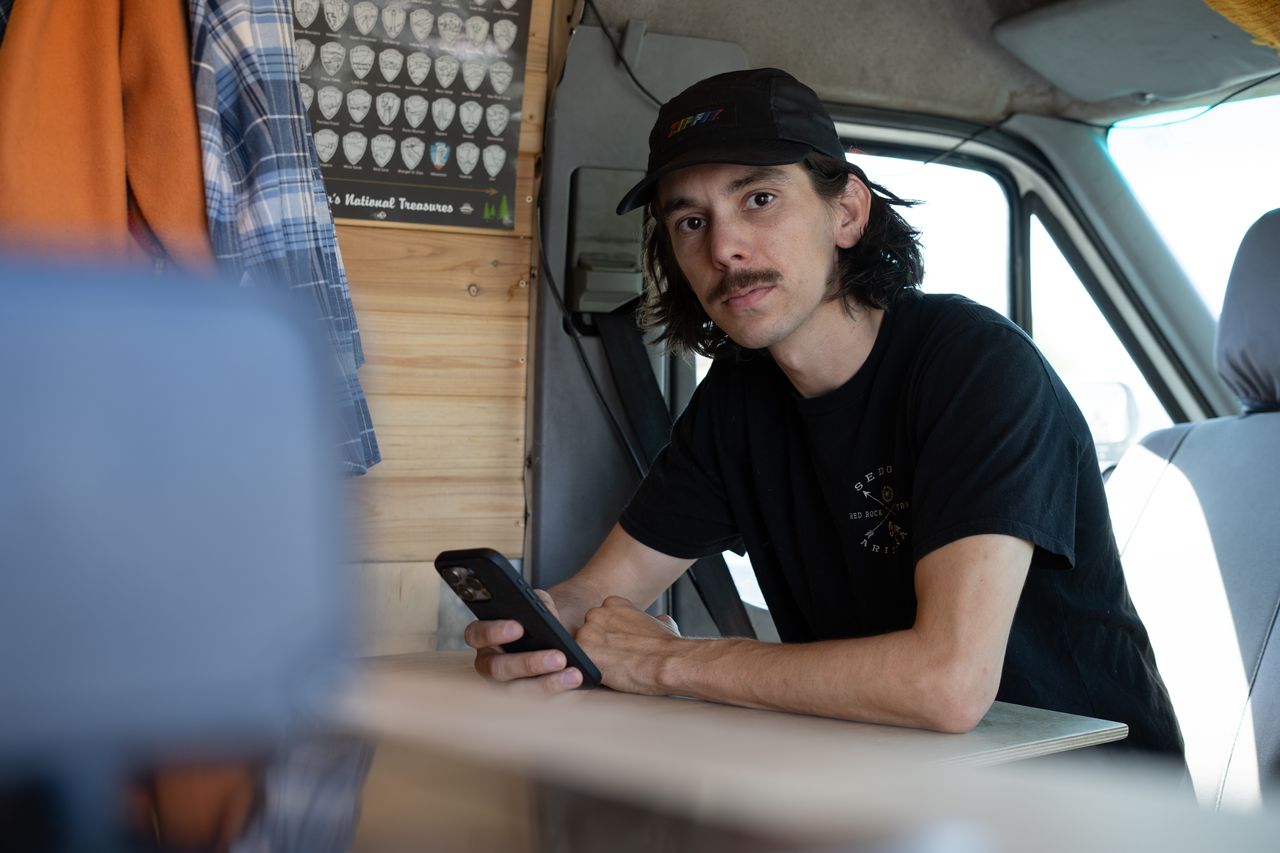Welcome to the Era of the $10,000 Designer Dorm Room
College students hungry for comfort and TikTok acclaim are pouring extra creativity into decorating their living spaces
Dorm rooms are designed to be utilitarian: 12-by-19 feet of standard-issue furniture and cinder-block walls.
Don’t tell that to today’s college freshmen.
At schools across the country, students are locked in unofficial competitions for who can make their dorms the least dorm like. Some wealthier families are spending hundreds of dollars or more on dormitory décor, even hiring designers. Other students are doing time-intensive DIY projects on the cheap. Some of those efforts culminate in dorm-room-transformation videos that rack up millions of views on TikTok.
The over-the-top rooms are often a collaboration between kids and their parents and stand as a contrast to last year, when many students weren’t allowed to have anyone help them move in at all due to Covid-19 concerns.
University of Mississippi freshmen Ansley Spinks and Taylor Robinson live in one of the most viral examples. The barren “before” and tricked-out “after” TikTok video of their violet-accented room has 3.8 million views and thousands of comments to the tune of, “OMG that looks like a room in a normal house.”
The two women and their moms, who didn’t meet until move-in day, had been sending each other messages since late May. They ordered light-up signs spelling out their names off Etsy, picked out matching bedding and built a virtual 3-D model of the room to workshop layouts, landing on one with a dedicated lounge space for watching TV.
Amber Park, Ansley’s mother, says the eight-hour assembly and roughly $2,000 they spent (that the girls largely funded themselves) is nothing compared with what she’s heard some other moms say they pay.
“It’s a crazy thing, especially in the South,” says Ms. Park, a 48-year-old human-resources consultant who lives in Marietta, Ga.
Dozens of families pay Dawn Thomas of After Five Designs as much as $10,000 to give their kids magazine-worthy rooms. Ms. Thomas has been decorating dorms at schools like the University of Alabama, Ole Miss and UCLA for 19 years. She says this year is different in how much pressure students are putting on themselves to have perfectly Instagrammable rooms. The $1,050 cabinet she designed to camouflage a mini-fridge sold out in a matter of weeks.
“Some days I go, ‘Do people do all this for a picture? Are they doing it for Instagram?’” says Ms. Thomas, who is based in Jackson, Miss. She says she gets effusive thank-you texts from moms when they’re back home for giving their kids a cozy place to live.
For Sydney Hargrove, having a swoon-worthy room is a matter of identity. The 18-year-old sophomore at New York City’s Hunter College says she made a lot of her friends during her freshman year by leaving her door open. This year’s room features a wall-to-wall green shag rug and black-and-white polka dotted peel-and-stick wallpaper.
Some of the two million people who viewed the TikTok of her room have criticised her for investing so much time and money in a space she’s spending less than a year in. She says the effort is worth it—and that she spent a lot less than people think. (About $100 this year and $300 last, she says, which she earned at her summer job working at a New Jersey beach.)
“With all the things going on in the world, there’s so much uncertainty, and New York is a tumultuous place to live, so coming back to this dorm is a form of therapy,” she says.
Allyson Schall, a senior at Mount Vernon Nazarene University in Mount Vernon, Ohio, has done up her dorm every year. She believes this year’s edition takes the cake. As a residential adviser, she wanted to create a space where freshmen on her floor would feel comfortable hanging out.
“It looked like a jail cell in the beginning,” Ms. Schall, 21, says.
She leveraged her summer job at Target to snatch up a $300 midcentury-modern-inspired armchair on sale for $80. She rigged an outdoor lantern to the ceiling using zip ties and command strips for mood lighting.
Her parents were supportive of her passion for interior design—until they had to help unload three cars’ worth of belongings, including a headboard her father built.
Bayla Felton-Jones, a freshman at Elizabeth City State University, in Elizabeth City, N.C., spent days this past summer planning every inch of his “light and airy modern” room. That includes the spacing of the honours certificates above his bed and the fluffy grey welcome mat outside his door.
“I want my college experience to be one I can remember, since I got robbed of high school with Covid, and my room is a part of that,” says Mr. Felton-Jones, 18.
His roommate, Quinn Miller, missed the memo.
Unable to find Mr. Miller on Instagram or Facebook before move-in on Aug. 16, Mr. Felton-Jones hoped for the best. He got pure practicality: blank walls, one pillow and a towel thrown over the end of the bed.
Mr. Miller won’t argue that he’s a minimalist. “I just sleep here pretty much,” says Mr. Miller, 20. “I don’t see a point in spending money on things that I don’t need.”
Mr. Felton-Jones’s friends and parents find the contrast between the two halves of the room hilarious. They tell him that when they walk in, “You first look at heaven, and then you look over and you’re like, ‘Oh, well, never mind.’ ”
His saving grace? The unmade bed is at least in his colour scheme.
 Copyright 2020, Dow Jones & Company, Inc. All Rights Reserved Worldwide. LEARN MORE
Copyright 2020, Dow Jones & Company, Inc. All Rights Reserved Worldwide. LEARN MORE
This stylish family home combines a classic palette and finishes with a flexible floorplan
Just 55 minutes from Sydney, make this your creative getaway located in the majestic Hawkesbury region.
As Paris makes its final preparations for the Olympic games, its residents are busy with their own—packing their suitcases, confirming their reservations, and getting out of town.
Worried about the hordes of crowds and overall chaos the Olympics could bring, Parisians are fleeing the city in droves and inundating resort cities around the country. Hotels and holiday rentals in some of France’s most popular vacation destinations—from the French Riviera in the south to the beaches of Normandy in the north—say they are expecting massive crowds this year in advance of the Olympics. The games will run from July 26-Aug. 1.
“It’s already a major holiday season for us, and beyond that, we have the Olympics,” says Stéphane Personeni, general manager of the Lily of the Valley hotel in Saint Tropez. “People began booking early this year.”
Personeni’s hotel typically has no issues filling its rooms each summer—by May of each year, the luxury hotel typically finds itself completely booked out for the months of July and August. But this year, the 53-room hotel began filling up for summer reservations in February.
“We told our regular guests that everything—hotels, apartments, villas—are going to be hard to find this summer,” Personeni says. His neighbours around Saint Tropez say they’re similarly booked up.
As of March, the online marketplace Gens de Confiance (“Trusted People”), saw a 50% increase in reservations from Parisians seeking vacation rentals outside the capital during the Olympics.
Already, August is a popular vacation time for the French. With a minimum of five weeks of vacation mandated by law, many decide to take the entire month off, renting out villas in beachside destinations for longer periods.
But beyond the typical August travel, the Olympics are having a real impact, says Bertille Marchal, a spokesperson for Gens de Confiance.
“We’ve seen nearly three times more reservations for the dates of the Olympics than the following two weeks,” Marchal says. “The increase is definitely linked to the Olympic Games.”

Getty Images
According to the site, the most sought-out vacation destinations are Morbihan and Loire-Atlantique, a seaside region in the northwest; le Var, a coastal area within the southeast of France along the Côte d’Azur; and the island of Corsica in the Mediterranean.
Meanwhile, the Olympics haven’t necessarily been a boon to foreign tourism in the country. Many tourists who might have otherwise come to France are avoiding it this year in favour of other European capitals. In Paris, demand for stays at high-end hotels has collapsed, with bookings down 50% in July compared to last year, according to UMIH Prestige, which represents hotels charging at least €800 ($865) a night for rooms.
Earlier this year, high-end restaurants and concierges said the Olympics might even be an opportunity to score a hard-get-seat at the city’s fine dining.
In the Occitanie region in southwest France, the overall number of reservations this summer hasn’t changed much from last year, says Vincent Gare, president of the regional tourism committee there.
“But looking further at the numbers, we do see an increase in the clientele coming from the Paris region,” Gare told Le Figaro, noting that the increase in reservations has fallen directly on the dates of the Olympic games.
Michel Barré, a retiree living in Paris’s Le Marais neighbourhood, is one of those opting for the beach rather than the opening ceremony. In January, he booked a stay in Normandy for two weeks.
“Even though it’s a major European capital, Paris is still a small city—it’s a massive effort to host all of these events,” Barré says. “The Olympics are going to be a mess.”
More than anything, he just wants some calm after an event-filled summer in Paris, which just before the Olympics experienced the drama of a snap election called by Macron.
“It’s been a hectic summer here,” he says.

AFP via Getty Images
Parisians—Barré included—feel that the city, by over-catering to its tourists, is driving out many residents.
Parts of the Seine—usually one of the most popular summertime hangout spots —have been closed off for weeks as the city installs bleachers and Olympics signage. In certain neighbourhoods, residents will need to scan a QR code with police to access their own apartments. And from the Olympics to Sept. 8, Paris is nearly doubling the price of transit tickets from €2.15 to €4 per ride.
The city’s clear willingness to capitalise on its tourists has motivated some residents to do the same. In March, the number of active Airbnb listings in Paris reached an all-time high as hosts rushed to list their apartments. Listings grew 40% from the same time last year, according to the company.
With their regular clients taking off, Parisian restaurants and merchants are complaining that business is down.
“Are there any Parisians left in Paris?” Alaine Fontaine, president of the restaurant industry association, told the radio station Franceinfo on Sunday. “For the last three weeks, there haven’t been any here.”
Still, for all the talk of those leaving, there are plenty who have decided to stick around.
Jay Swanson, an American expat and YouTuber, can’t imagine leaving during the Olympics—he secured his tickets to see ping pong and volleyball last year. He’s also less concerned about the crowds and road closures than others, having just put together a series of videos explaining how to navigate Paris during the games.
“It’s been 100 years since the Games came to Paris; when else will we get a chance to host the world like this?” Swanson says. “So many Parisians are leaving and tourism is down, so not only will it be quiet but the only people left will be here for a party.”
This stylish family home combines a classic palette and finishes with a flexible floorplan
Just 55 minutes from Sydney, make this your creative getaway located in the majestic Hawkesbury region.






















